Economic Principles Assignment: Tax Effects and Market Analysis
VerifiedAdded on 2020/05/28
|9
|1405
|56
Homework Assignment
AI Summary
This economics assignment delves into the economic principles related to taxation, specifically focusing on the impact of a tax on sugary drinks. The assignment begins by defining key economic concepts such as tax incidence, exploring how the burden of a tax is distributed among consumers and producers. It then proceeds to analyze the sugary drinks market using supply and demand models, illustrating the effects of the tax on equilibrium price and quantity, and creating figures to demonstrate the shifts in supply and demand curves. The analysis extends to the effects of the tax on related markets, such as the sugar market and the market for substitute beverages. Finally, the assignment evaluates the effectiveness of the tax policy, considering demand elasticity and factors influencing consumer behavior, such as income levels and age groups, to assess how these factors influence the success of the tax in reducing sugary drink consumption. The assignment concludes by discussing the implications of the tax policy and its potential impact on various consumer groups.
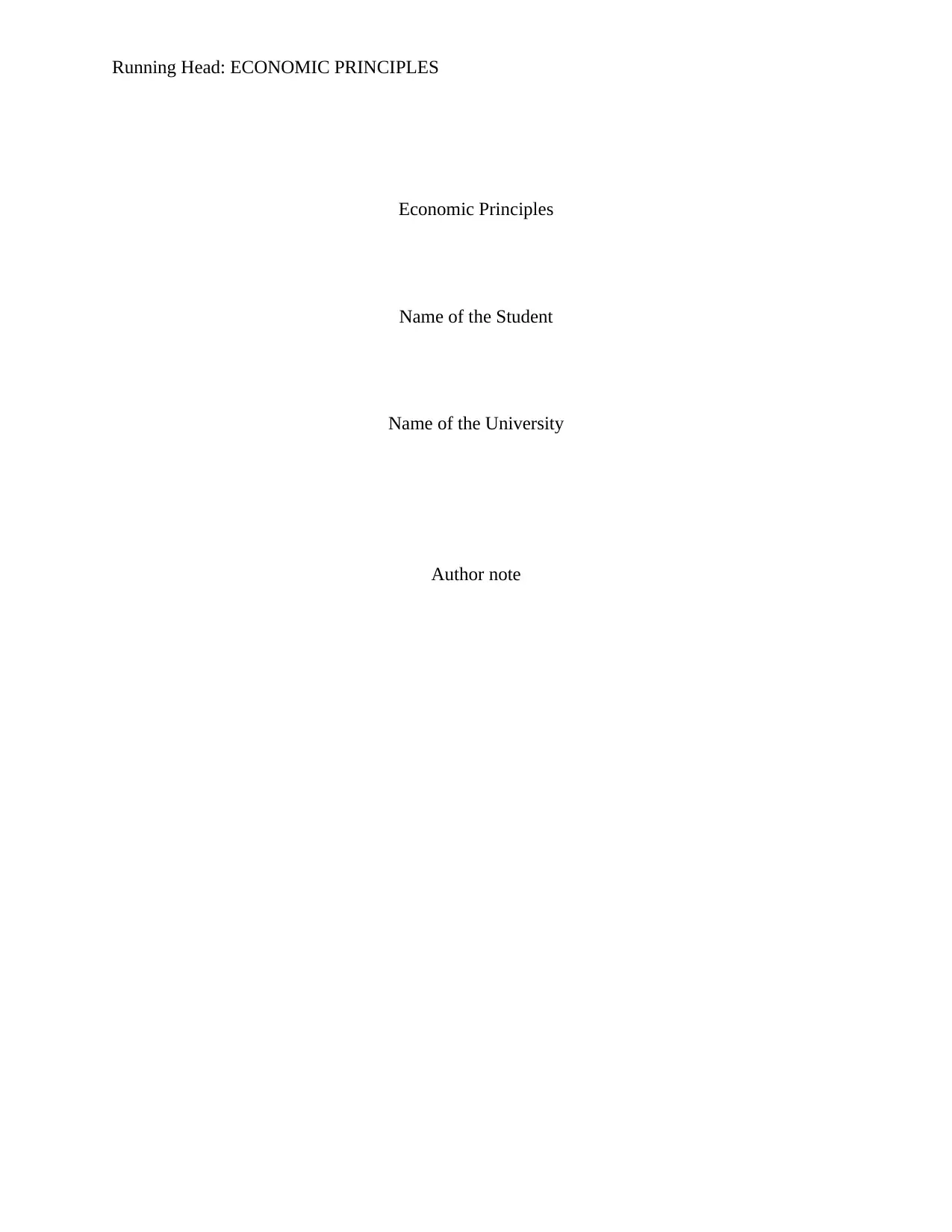
Running Head: ECONOMIC PRINCIPLES
Economic Principles
Name of the Student
Name of the University
Author note
Economic Principles
Name of the Student
Name of the University
Author note
Paraphrase This Document
Need a fresh take? Get an instant paraphrase of this document with our AI Paraphraser
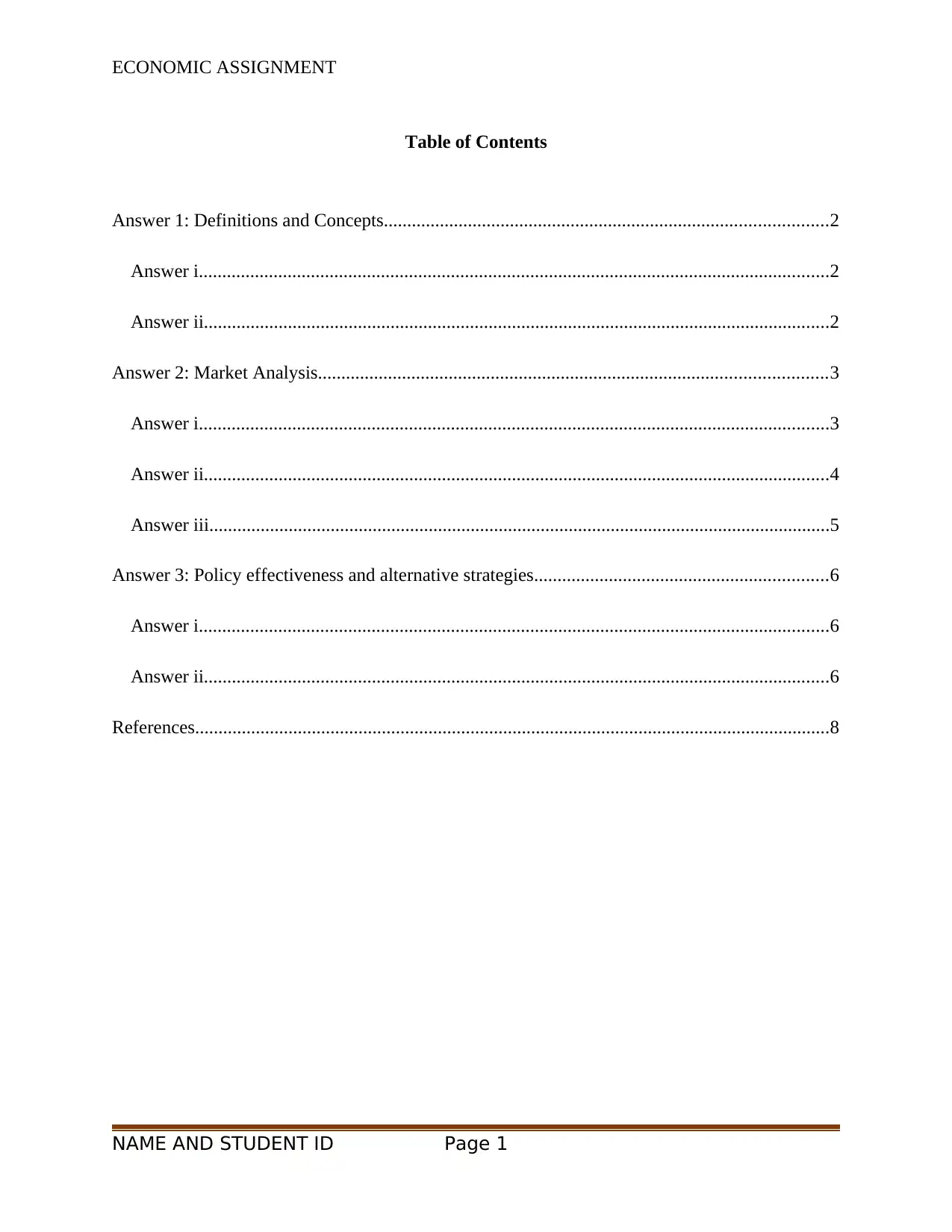
ECONOMIC ASSIGNMENT
Table of Contents
Answer 1: Definitions and Concepts...............................................................................................2
Answer i.......................................................................................................................................2
Answer ii......................................................................................................................................2
Answer 2: Market Analysis.............................................................................................................3
Answer i.......................................................................................................................................3
Answer ii......................................................................................................................................4
Answer iii.....................................................................................................................................5
Answer 3: Policy effectiveness and alternative strategies...............................................................6
Answer i.......................................................................................................................................6
Answer ii......................................................................................................................................6
References........................................................................................................................................8
NAME AND STUDENT ID Page 1
Table of Contents
Answer 1: Definitions and Concepts...............................................................................................2
Answer i.......................................................................................................................................2
Answer ii......................................................................................................................................2
Answer 2: Market Analysis.............................................................................................................3
Answer i.......................................................................................................................................3
Answer ii......................................................................................................................................4
Answer iii.....................................................................................................................................5
Answer 3: Policy effectiveness and alternative strategies...............................................................6
Answer i.......................................................................................................................................6
Answer ii......................................................................................................................................6
References........................................................................................................................................8
NAME AND STUDENT ID Page 1
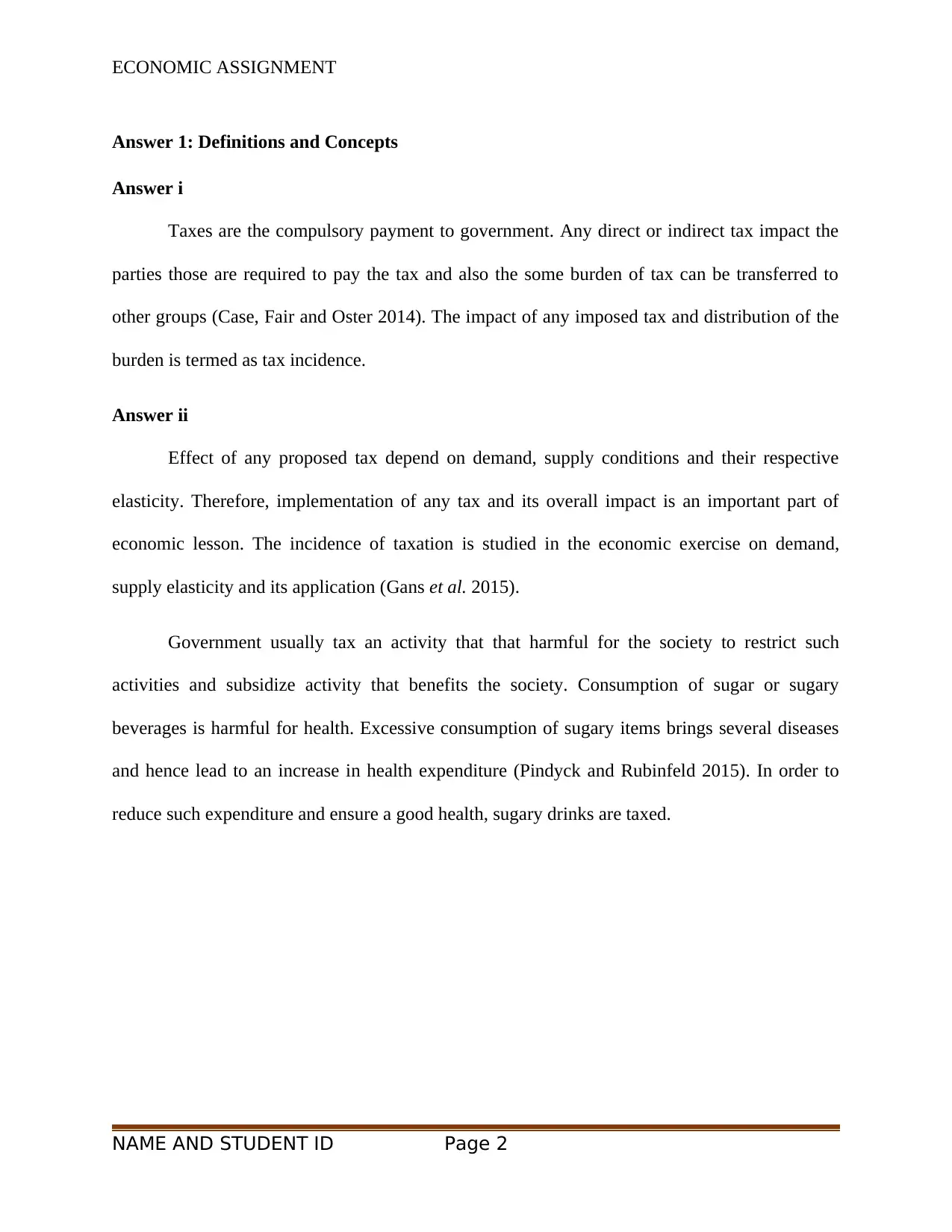
ECONOMIC ASSIGNMENT
Answer 1: Definitions and Concepts
Answer i
Taxes are the compulsory payment to government. Any direct or indirect tax impact the
parties those are required to pay the tax and also the some burden of tax can be transferred to
other groups (Case, Fair and Oster 2014). The impact of any imposed tax and distribution of the
burden is termed as tax incidence.
Answer ii
Effect of any proposed tax depend on demand, supply conditions and their respective
elasticity. Therefore, implementation of any tax and its overall impact is an important part of
economic lesson. The incidence of taxation is studied in the economic exercise on demand,
supply elasticity and its application (Gans et al. 2015).
Government usually tax an activity that that harmful for the society to restrict such
activities and subsidize activity that benefits the society. Consumption of sugar or sugary
beverages is harmful for health. Excessive consumption of sugary items brings several diseases
and hence lead to an increase in health expenditure (Pindyck and Rubinfeld 2015). In order to
reduce such expenditure and ensure a good health, sugary drinks are taxed.
NAME AND STUDENT ID Page 2
Answer 1: Definitions and Concepts
Answer i
Taxes are the compulsory payment to government. Any direct or indirect tax impact the
parties those are required to pay the tax and also the some burden of tax can be transferred to
other groups (Case, Fair and Oster 2014). The impact of any imposed tax and distribution of the
burden is termed as tax incidence.
Answer ii
Effect of any proposed tax depend on demand, supply conditions and their respective
elasticity. Therefore, implementation of any tax and its overall impact is an important part of
economic lesson. The incidence of taxation is studied in the economic exercise on demand,
supply elasticity and its application (Gans et al. 2015).
Government usually tax an activity that that harmful for the society to restrict such
activities and subsidize activity that benefits the society. Consumption of sugar or sugary
beverages is harmful for health. Excessive consumption of sugary items brings several diseases
and hence lead to an increase in health expenditure (Pindyck and Rubinfeld 2015). In order to
reduce such expenditure and ensure a good health, sugary drinks are taxed.
NAME AND STUDENT ID Page 2
⊘ This is a preview!⊘
Do you want full access?
Subscribe today to unlock all pages.

Trusted by 1+ million students worldwide
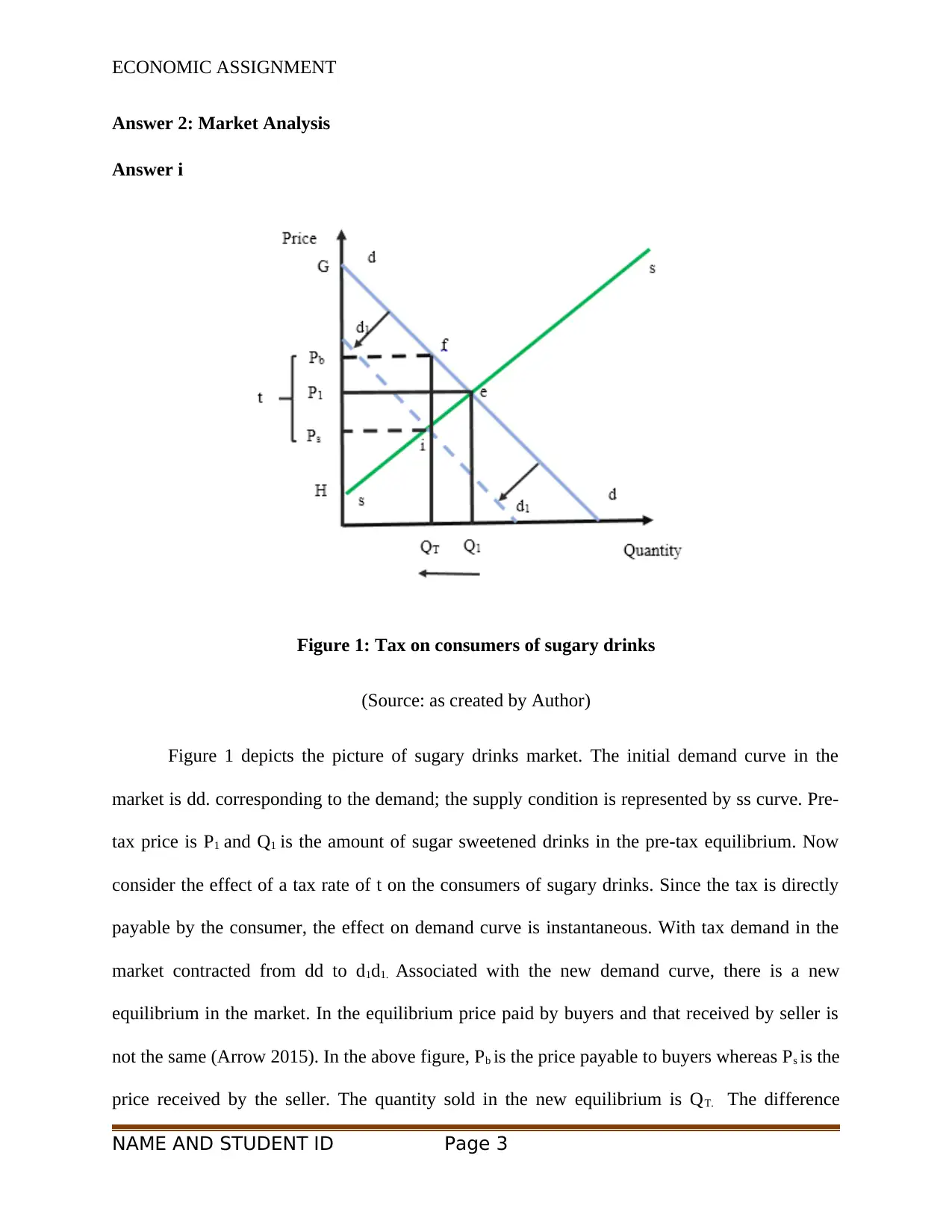
ECONOMIC ASSIGNMENT
Answer 2: Market Analysis
Answer i
Figure 1: Tax on consumers of sugary drinks
(Source: as created by Author)
Figure 1 depicts the picture of sugary drinks market. The initial demand curve in the
market is dd. corresponding to the demand; the supply condition is represented by ss curve. Pre-
tax price is P1 and Q1 is the amount of sugar sweetened drinks in the pre-tax equilibrium. Now
consider the effect of a tax rate of t on the consumers of sugary drinks. Since the tax is directly
payable by the consumer, the effect on demand curve is instantaneous. With tax demand in the
market contracted from dd to d1d1. Associated with the new demand curve, there is a new
equilibrium in the market. In the equilibrium price paid by buyers and that received by seller is
not the same (Arrow 2015). In the above figure, Pb is the price payable to buyers whereas Ps is the
price received by the seller. The quantity sold in the new equilibrium is QT. The difference
NAME AND STUDENT ID Page 3
Answer 2: Market Analysis
Answer i
Figure 1: Tax on consumers of sugary drinks
(Source: as created by Author)
Figure 1 depicts the picture of sugary drinks market. The initial demand curve in the
market is dd. corresponding to the demand; the supply condition is represented by ss curve. Pre-
tax price is P1 and Q1 is the amount of sugar sweetened drinks in the pre-tax equilibrium. Now
consider the effect of a tax rate of t on the consumers of sugary drinks. Since the tax is directly
payable by the consumer, the effect on demand curve is instantaneous. With tax demand in the
market contracted from dd to d1d1. Associated with the new demand curve, there is a new
equilibrium in the market. In the equilibrium price paid by buyers and that received by seller is
not the same (Arrow 2015). In the above figure, Pb is the price payable to buyers whereas Ps is the
price received by the seller. The quantity sold in the new equilibrium is QT. The difference
NAME AND STUDENT ID Page 3
Paraphrase This Document
Need a fresh take? Get an instant paraphrase of this document with our AI Paraphraser
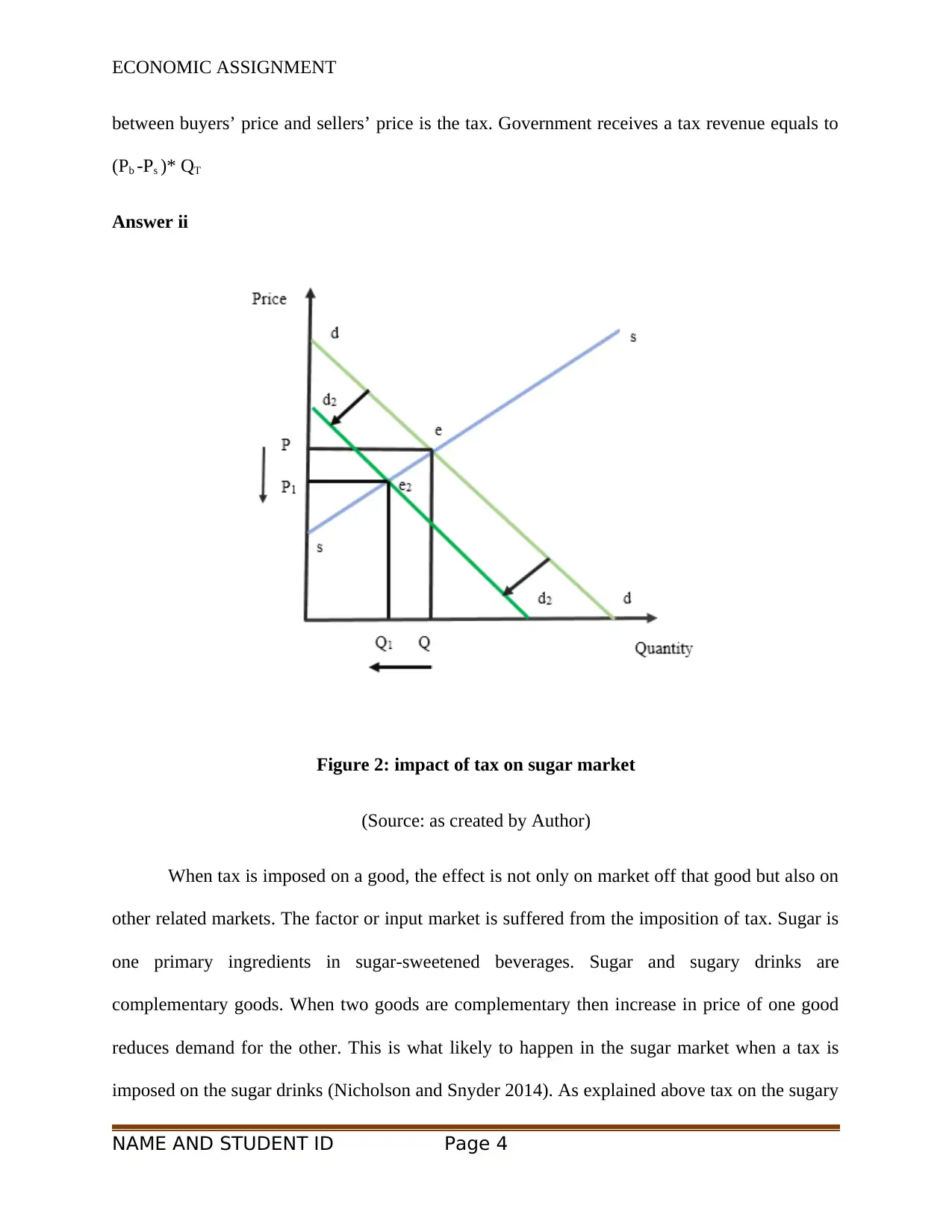
ECONOMIC ASSIGNMENT
between buyers’ price and sellers’ price is the tax. Government receives a tax revenue equals to
(Pb -Ps )* QT
Answer ii
Figure 2: impact of tax on sugar market
(Source: as created by Author)
When tax is imposed on a good, the effect is not only on market off that good but also on
other related markets. The factor or input market is suffered from the imposition of tax. Sugar is
one primary ingredients in sugar-sweetened beverages. Sugar and sugary drinks are
complementary goods. When two goods are complementary then increase in price of one good
reduces demand for the other. This is what likely to happen in the sugar market when a tax is
imposed on the sugar drinks (Nicholson and Snyder 2014). As explained above tax on the sugary
NAME AND STUDENT ID Page 4
between buyers’ price and sellers’ price is the tax. Government receives a tax revenue equals to
(Pb -Ps )* QT
Answer ii
Figure 2: impact of tax on sugar market
(Source: as created by Author)
When tax is imposed on a good, the effect is not only on market off that good but also on
other related markets. The factor or input market is suffered from the imposition of tax. Sugar is
one primary ingredients in sugar-sweetened beverages. Sugar and sugary drinks are
complementary goods. When two goods are complementary then increase in price of one good
reduces demand for the other. This is what likely to happen in the sugar market when a tax is
imposed on the sugar drinks (Nicholson and Snyder 2014). As explained above tax on the sugary
NAME AND STUDENT ID Page 4
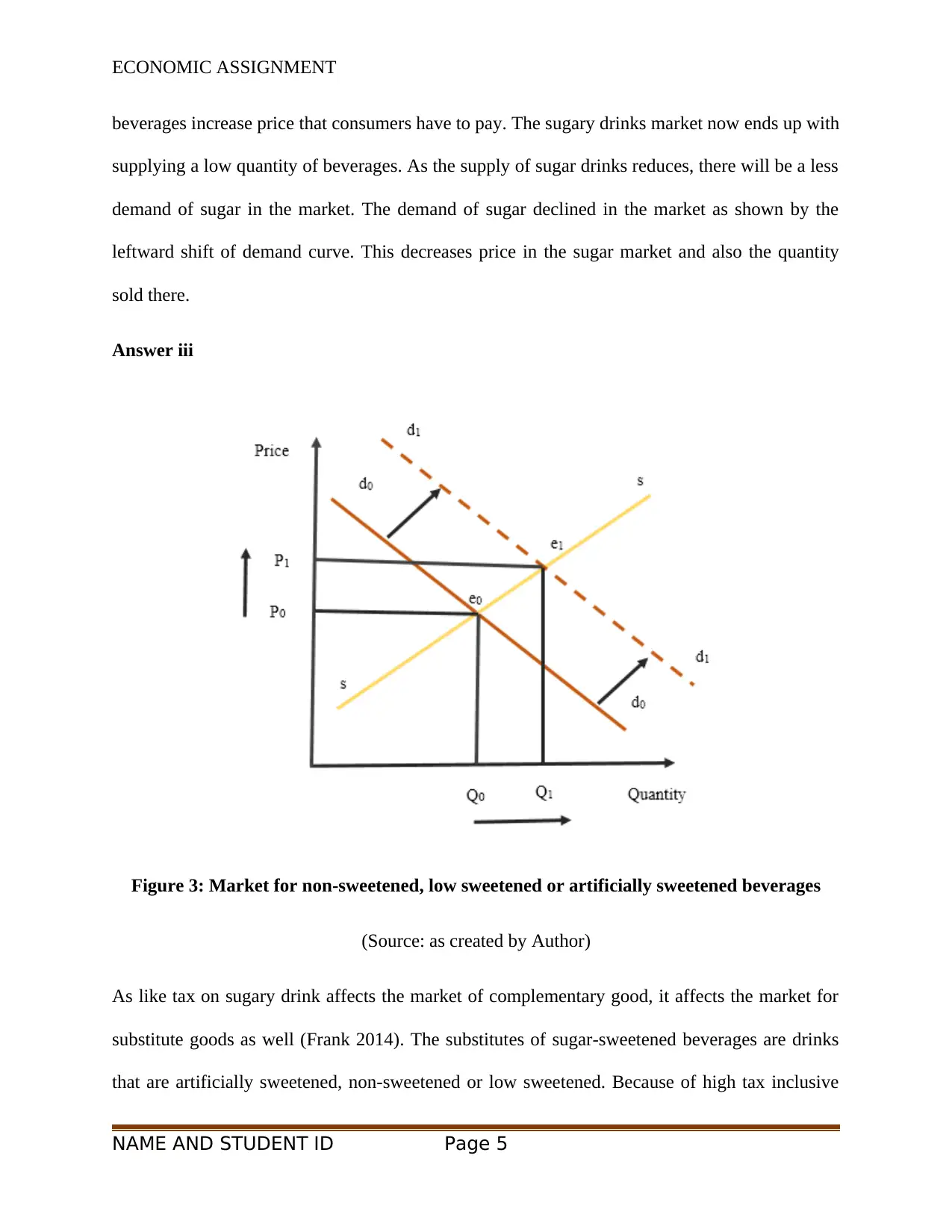
ECONOMIC ASSIGNMENT
beverages increase price that consumers have to pay. The sugary drinks market now ends up with
supplying a low quantity of beverages. As the supply of sugar drinks reduces, there will be a less
demand of sugar in the market. The demand of sugar declined in the market as shown by the
leftward shift of demand curve. This decreases price in the sugar market and also the quantity
sold there.
Answer iii
Figure 3: Market for non-sweetened, low sweetened or artificially sweetened beverages
(Source: as created by Author)
As like tax on sugary drink affects the market of complementary good, it affects the market for
substitute goods as well (Frank 2014). The substitutes of sugar-sweetened beverages are drinks
that are artificially sweetened, non-sweetened or low sweetened. Because of high tax inclusive
NAME AND STUDENT ID Page 5
beverages increase price that consumers have to pay. The sugary drinks market now ends up with
supplying a low quantity of beverages. As the supply of sugar drinks reduces, there will be a less
demand of sugar in the market. The demand of sugar declined in the market as shown by the
leftward shift of demand curve. This decreases price in the sugar market and also the quantity
sold there.
Answer iii
Figure 3: Market for non-sweetened, low sweetened or artificially sweetened beverages
(Source: as created by Author)
As like tax on sugary drink affects the market of complementary good, it affects the market for
substitute goods as well (Frank 2014). The substitutes of sugar-sweetened beverages are drinks
that are artificially sweetened, non-sweetened or low sweetened. Because of high tax inclusive
NAME AND STUDENT ID Page 5
⊘ This is a preview!⊘
Do you want full access?
Subscribe today to unlock all pages.

Trusted by 1+ million students worldwide
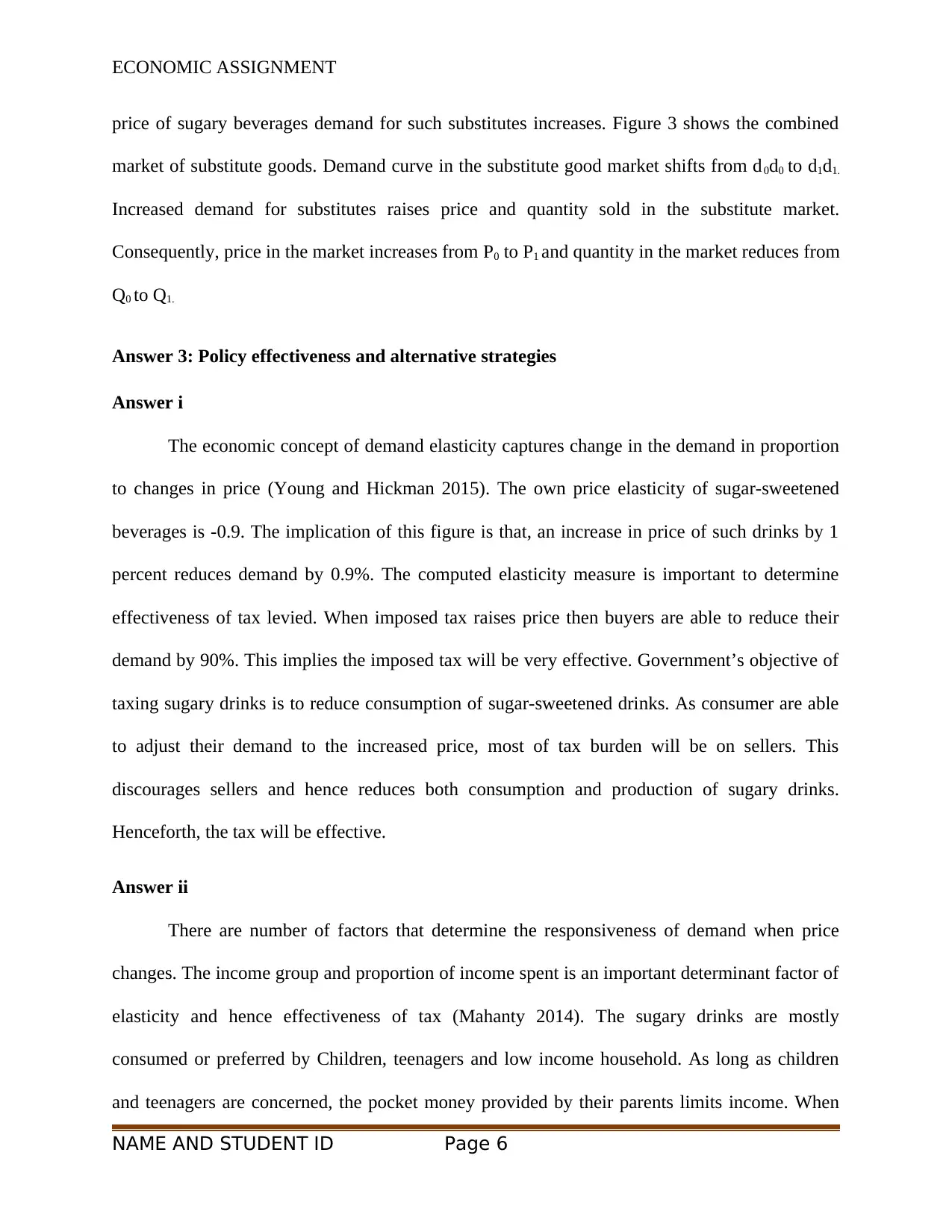
ECONOMIC ASSIGNMENT
price of sugary beverages demand for such substitutes increases. Figure 3 shows the combined
market of substitute goods. Demand curve in the substitute good market shifts from d0d0 to d1d1.
Increased demand for substitutes raises price and quantity sold in the substitute market.
Consequently, price in the market increases from P0 to P1 and quantity in the market reduces from
Q0 to Q1.
Answer 3: Policy effectiveness and alternative strategies
Answer i
The economic concept of demand elasticity captures change in the demand in proportion
to changes in price (Young and Hickman 2015). The own price elasticity of sugar-sweetened
beverages is -0.9. The implication of this figure is that, an increase in price of such drinks by 1
percent reduces demand by 0.9%. The computed elasticity measure is important to determine
effectiveness of tax levied. When imposed tax raises price then buyers are able to reduce their
demand by 90%. This implies the imposed tax will be very effective. Government’s objective of
taxing sugary drinks is to reduce consumption of sugar-sweetened drinks. As consumer are able
to adjust their demand to the increased price, most of tax burden will be on sellers. This
discourages sellers and hence reduces both consumption and production of sugary drinks.
Henceforth, the tax will be effective.
Answer ii
There are number of factors that determine the responsiveness of demand when price
changes. The income group and proportion of income spent is an important determinant factor of
elasticity and hence effectiveness of tax (Mahanty 2014). The sugary drinks are mostly
consumed or preferred by Children, teenagers and low income household. As long as children
and teenagers are concerned, the pocket money provided by their parents limits income. When
NAME AND STUDENT ID Page 6
price of sugary beverages demand for such substitutes increases. Figure 3 shows the combined
market of substitute goods. Demand curve in the substitute good market shifts from d0d0 to d1d1.
Increased demand for substitutes raises price and quantity sold in the substitute market.
Consequently, price in the market increases from P0 to P1 and quantity in the market reduces from
Q0 to Q1.
Answer 3: Policy effectiveness and alternative strategies
Answer i
The economic concept of demand elasticity captures change in the demand in proportion
to changes in price (Young and Hickman 2015). The own price elasticity of sugar-sweetened
beverages is -0.9. The implication of this figure is that, an increase in price of such drinks by 1
percent reduces demand by 0.9%. The computed elasticity measure is important to determine
effectiveness of tax levied. When imposed tax raises price then buyers are able to reduce their
demand by 90%. This implies the imposed tax will be very effective. Government’s objective of
taxing sugary drinks is to reduce consumption of sugar-sweetened drinks. As consumer are able
to adjust their demand to the increased price, most of tax burden will be on sellers. This
discourages sellers and hence reduces both consumption and production of sugary drinks.
Henceforth, the tax will be effective.
Answer ii
There are number of factors that determine the responsiveness of demand when price
changes. The income group and proportion of income spent is an important determinant factor of
elasticity and hence effectiveness of tax (Mahanty 2014). The sugary drinks are mostly
consumed or preferred by Children, teenagers and low income household. As long as children
and teenagers are concerned, the pocket money provided by their parents limits income. When
NAME AND STUDENT ID Page 6
Paraphrase This Document
Need a fresh take? Get an instant paraphrase of this document with our AI Paraphraser
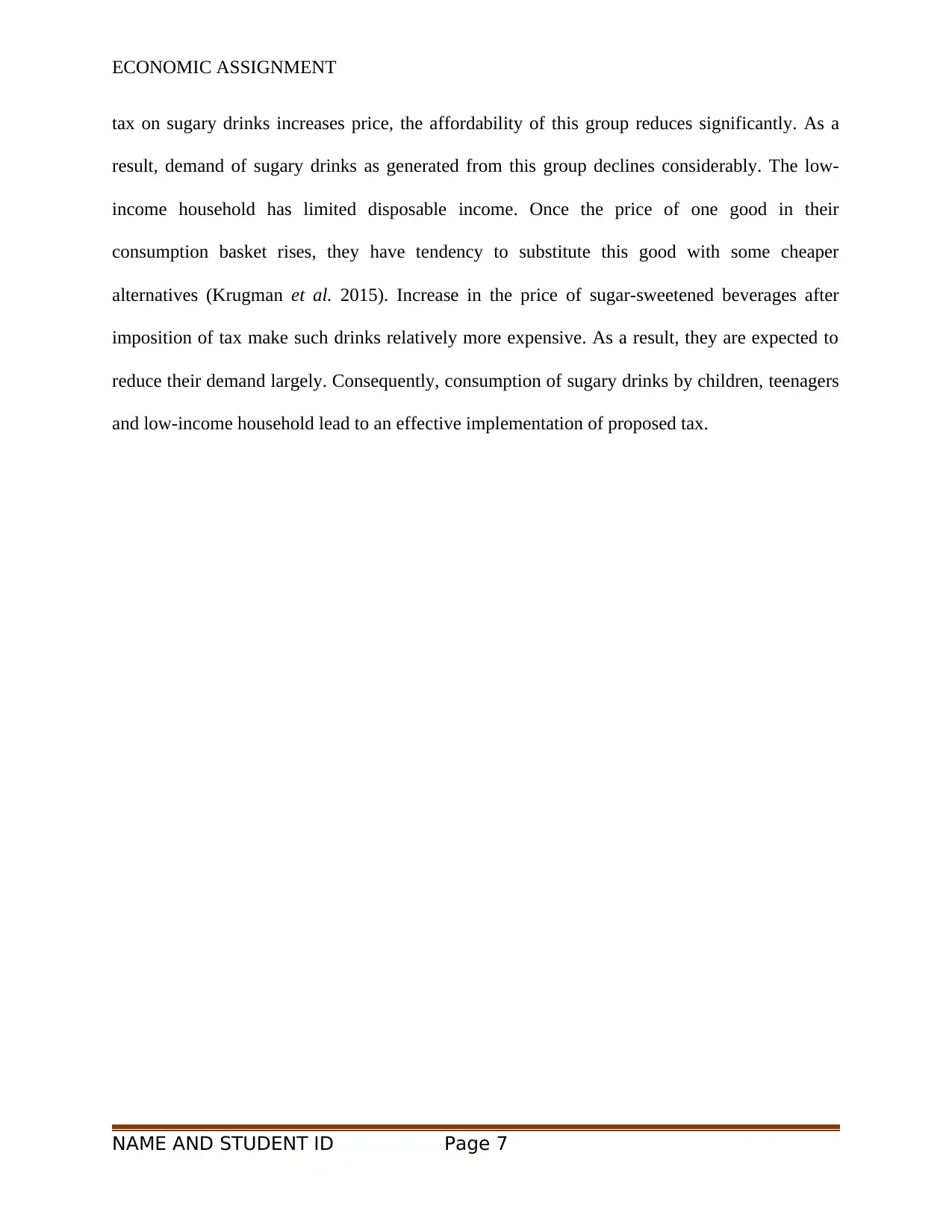
ECONOMIC ASSIGNMENT
tax on sugary drinks increases price, the affordability of this group reduces significantly. As a
result, demand of sugary drinks as generated from this group declines considerably. The low-
income household has limited disposable income. Once the price of one good in their
consumption basket rises, they have tendency to substitute this good with some cheaper
alternatives (Krugman et al. 2015). Increase in the price of sugar-sweetened beverages after
imposition of tax make such drinks relatively more expensive. As a result, they are expected to
reduce their demand largely. Consequently, consumption of sugary drinks by children, teenagers
and low-income household lead to an effective implementation of proposed tax.
NAME AND STUDENT ID Page 7
tax on sugary drinks increases price, the affordability of this group reduces significantly. As a
result, demand of sugary drinks as generated from this group declines considerably. The low-
income household has limited disposable income. Once the price of one good in their
consumption basket rises, they have tendency to substitute this good with some cheaper
alternatives (Krugman et al. 2015). Increase in the price of sugar-sweetened beverages after
imposition of tax make such drinks relatively more expensive. As a result, they are expected to
reduce their demand largely. Consequently, consumption of sugary drinks by children, teenagers
and low-income household lead to an effective implementation of proposed tax.
NAME AND STUDENT ID Page 7
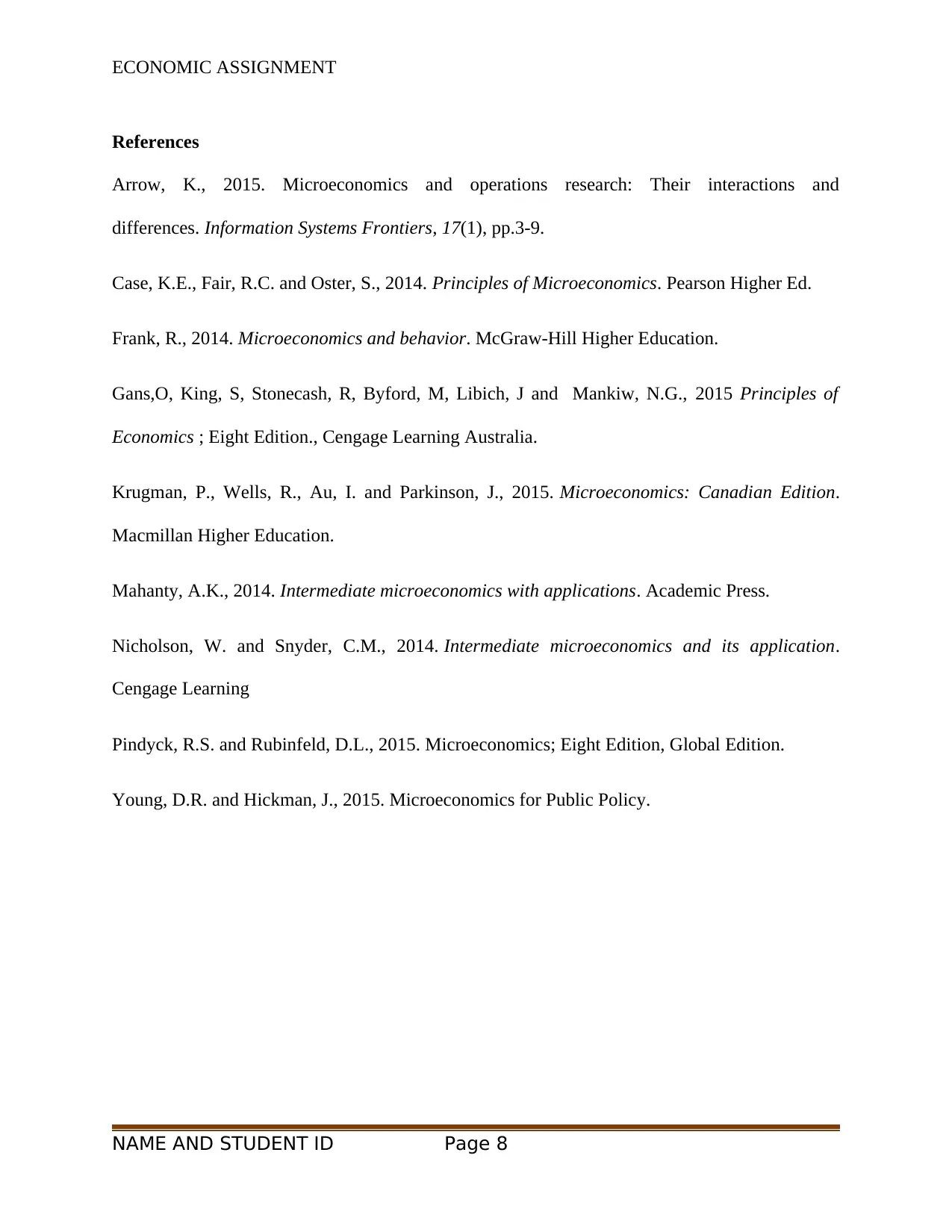
ECONOMIC ASSIGNMENT
References
Arrow, K., 2015. Microeconomics and operations research: Their interactions and
differences. Information Systems Frontiers, 17(1), pp.3-9.
Case, K.E., Fair, R.C. and Oster, S., 2014. Principles of Microeconomics. Pearson Higher Ed.
Frank, R., 2014. Microeconomics and behavior. McGraw-Hill Higher Education.
Gans,O, King, S, Stonecash, R, Byford, M, Libich, J and Mankiw, N.G., 2015 Principles of
Economics ; Eight Edition., Cengage Learning Australia.
Krugman, P., Wells, R., Au, I. and Parkinson, J., 2015. Microeconomics: Canadian Edition.
Macmillan Higher Education.
Mahanty, A.K., 2014. Intermediate microeconomics with applications. Academic Press.
Nicholson, W. and Snyder, C.M., 2014. Intermediate microeconomics and its application.
Cengage Learning
Pindyck, R.S. and Rubinfeld, D.L., 2015. Microeconomics; Eight Edition, Global Edition.
Young, D.R. and Hickman, J., 2015. Microeconomics for Public Policy.
NAME AND STUDENT ID Page 8
References
Arrow, K., 2015. Microeconomics and operations research: Their interactions and
differences. Information Systems Frontiers, 17(1), pp.3-9.
Case, K.E., Fair, R.C. and Oster, S., 2014. Principles of Microeconomics. Pearson Higher Ed.
Frank, R., 2014. Microeconomics and behavior. McGraw-Hill Higher Education.
Gans,O, King, S, Stonecash, R, Byford, M, Libich, J and Mankiw, N.G., 2015 Principles of
Economics ; Eight Edition., Cengage Learning Australia.
Krugman, P., Wells, R., Au, I. and Parkinson, J., 2015. Microeconomics: Canadian Edition.
Macmillan Higher Education.
Mahanty, A.K., 2014. Intermediate microeconomics with applications. Academic Press.
Nicholson, W. and Snyder, C.M., 2014. Intermediate microeconomics and its application.
Cengage Learning
Pindyck, R.S. and Rubinfeld, D.L., 2015. Microeconomics; Eight Edition, Global Edition.
Young, D.R. and Hickman, J., 2015. Microeconomics for Public Policy.
NAME AND STUDENT ID Page 8
⊘ This is a preview!⊘
Do you want full access?
Subscribe today to unlock all pages.

Trusted by 1+ million students worldwide
1 out of 9
Related Documents
Your All-in-One AI-Powered Toolkit for Academic Success.
+13062052269
info@desklib.com
Available 24*7 on WhatsApp / Email
![[object Object]](/_next/static/media/star-bottom.7253800d.svg)
Unlock your academic potential
Copyright © 2020–2025 A2Z Services. All Rights Reserved. Developed and managed by ZUCOL.





